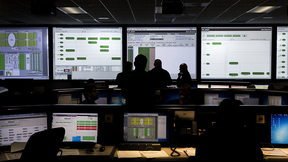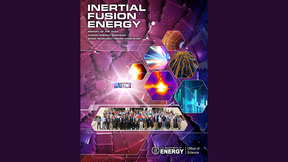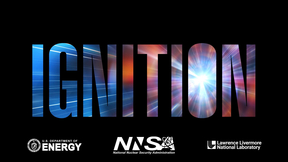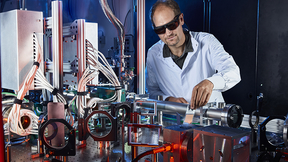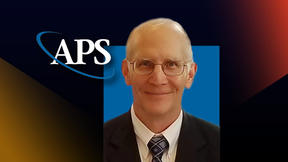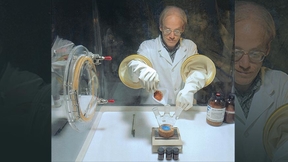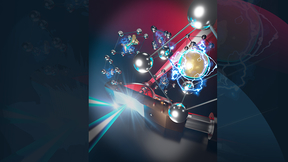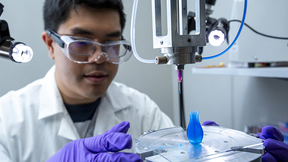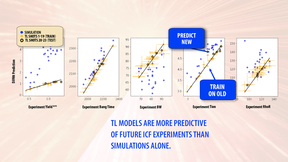Back
In a room illuminated by blinking lights and glowing monitors, more than 2,000 synchronized computers are triggered to run 5 million lines of code. The intricate code language is responsible for aligning and firing 192 laser beams — and carrying some 800 channels of target diagnostic data — efficiently and reliably several times a day. This isn’t a scene from a science…
Second in a series of articles describing the elements of Lawrence Livermore National Laboratory's fusion breakthrough. The National Ignition Facility (NIF) is the world’s biggest laser — three footballs fields could fit inside — but it’s what happened inside a capsule the size of a peppercorn that made scientific history on Dec. 5, 2022. The NIF experiment that produced…
First in a series of articles describing the elements of Lawrence Livermore National Laboratory's fusion breakthrough. It was the middle of the night on Dec. 5, 2022, and anticipation was building among the handful of researchers and technicians in the National Ignition Facility (NIF) control room. A set of pre-shot simulations had predicted a slightly better than 50-50…
Lawrence Livermore National Laboratory’s (LLNL) National Ignition Facility’s (NIF) recent scientific advances, including the achievement of fusion ignition in December, have increased interest among aspiring young scientists for the NIF&PS Summer Scholar Program. “That’s kind of the cool thing about this past year,” said Patrick Poole, the program director. “We had so…
Lawrence Livermore National Laboratory (LLNL)’s historic achievement of fusion ignition Dec. 5 at the National Ignition Facility (NIF) positions the United States with a “unique opportunity” to further lead the world scientific community’s pursuit of developing fusion as a future source of clean energy, according to a newly released report. Capitalizing on that opportunity…
The U.S. Department of Energy (DOE) and DOE’s National Nuclear Security Administration (NNSA) today (Dec. 13) announced the achievement of fusion ignition at Lawrence Livermore National Laboratory (LLNL) — a major scientific breakthrough decades in the making that will pave the way for advancements in national defense and the future of clean power. On Dec. 5, a team at…
Call it the shot heard ‘round the world. The monumental, first-ever demonstration of fusion ignition by Lawrence Livermore National Laboratory’s (LLNL) National Ignition Facility (NIF) marks a potentially world-changing breakthrough for fusion energy and a key initial step in a decades-long quest for limitless clean energy, U.S. government officials and LLNL scientists…
Researchers at Lawrence Livermore National Laboratory (LLNL) have discovered that ions behave differently in fusion reactions than previously expected, thus providing important insights for the future design of a laser–fusion energy source. The findings are featured in a new paper in the Nov. 14 issue of Nature Physics and is titled “Evidence for suprathermal ion…
Electromagnetic vortices occur naturally throughout the universe and have recently been observed in association with black holes. Over the last decade, scientists have sought methods to investigate how extremely strong electromagnetic vortices interact with matter, specifically plasma, in a laboratory setting. Plasma, known as the “fourth state of matter,” makes up nearly…
Bruce Remington, a distinguished member of the technical staff at Lawrence Livermore National Laboratory (LLNL), has been honored with the American Physical Society’s (APS) 2023 George E. Duvall Shock Compression Science Award, which recognizes contributions to understanding condensed matter and non-linear physics through shock compression. Since 1987, the award — the…
The last nuclear test, code-named Divider, took place 30 years ago, on Sept. 23, 1992. That year, President Bush declared a temporary moratorium on nuclear testing, which became permanent in 1995, during the Clinton administration. This ending of the era of nuclear testing coincided with a Presidential announcement of the beginning of stockpile stewardship. As the decision…
Investigating how solid matter behaves at enormous pressures, such as those found in the deep interiors of giant planets, is a great experimental challenge. To help address that challenge, Lawrence Livermore National Laboratory (LLNL) researchers and collaborators took a deep dive in understanding these extreme pressures. The work was just published in Nature Physics with…
Lawrence Livermore National Laboratory (LLNL) researchers and their collaborators have developed new high-energy pulse compression gratings that will be used in the world’s highest-power laser system, designed to deliver up to 10 petawatts (quadrillion watts) of peak power. A petawatt is about 1,000 times the capacity of the entire U.S. electric grid. The high-energy, low…
Lawrence Livermore National Laboratory (LLNL) scientist Alison Ruth Christopherson has earned the American Physical Society’s (APS) Marshall N. Rosenbluth Outstanding Doctoral Thesis award. The award recognizes exceptional early-career scientists who have performed original thesis work of outstanding scientific quality and achievement in the area of plasma physics…
The Burning Plasma Team has been awarded the 2022 John Dawson Award for Excellence in Plasma Physics Research by the American Physical Society. The team consists of members from Lawrence Livermore National Laboratory (LLNL) and from other institutions. The team was cited “for the first laboratory demonstration of a burning deuterium-tritium plasma where alpha heating…
Red dwarfs are the most abundant stars in the Milky Way, making up 70% of all stars. But the physics of their interiors is not well understood. Heat is generated in the core and travels outward to the surface, but it is not clear whether that process occurs via radiation, convection or a combination of the two. The key factor determining whether red dwarfs are radiation-…
Lawrence Livermore National Laboratory (LLNL) scientists and engineers have garnered three awards among the top 100 industrial inventions worldwide. The trade journal R&D World Magazine recently announced the winners of the awards, often called the “Oscars of invention,” recognizing new commercial products, technologies and materials that are available for sale or…
Lawrence Livermore National Laboratory (LLNL) researchers have designed a compact multi-petawatt laser that uses plasma transmission gratings to overcome the power limitations of conventional solid-state optical gratings. The design could enable construction of an ultrafast laser up to 1,000 times more powerful than existing lasers of the same size. Petawatt (quadrillion…
After decades of inertial confinement fusion research, a yield of more than 1.3 megajoules (MJ) was achieved at Lawrence Livermore National Laboratory’s (LLNL’s) National Ignition Facility (NIF) for the first time on Aug. 8, 2021, putting researchers at the threshold of fusion gain and achieving scientific ignition. On the one-year anniversary of this historic achievement,…
The IEEE Nuclear and Plasma Sciences Society (NPSS) announced a Lawrence Livermore National Laboratory (LLNL) team as the winner of its 2022 Transactions on Plasma Science (TPS) Best Paper Award for their work applying machine learning to inertial confinement fusion (ICF) experiments. In the paper, lead author Kelli Humbird and co-authors propose a novel technique for…

